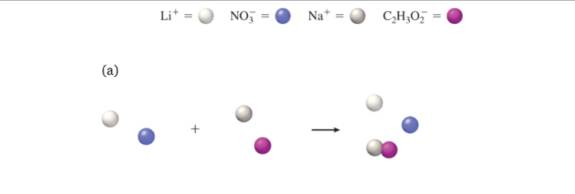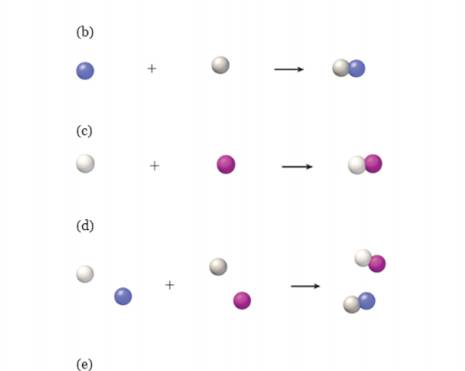
CHEMISTRY MCC CUSTOM W/CONNECT >CI<
16th Edition
ISBN: 9781260111811
Author: Burdge
Publisher: MCG CUSTOM
expand_more
expand_more
format_list_bulleted
Concept explainers
Textbook Question
Chapter 4.2, Problem 6CP
Which reaction is represented by the net ionic equation for the combination of aqueous solutions of


There is no net ionic equation. No reaction occurs.
Expert Solution & Answer
Want to see the full answer?
Check out a sample textbook solution
Chapter 4 Solutions
CHEMISTRY MCC CUSTOM W/CONNECT >CI<
Ch. 4.1 - Prob. 1PPACh. 4.1 - Prob. 1PPBCh. 4.1 - Prob. 1PPCCh. 4.1 - Prob. 1CPCh. 4.1 - Soluble molecular compounds are __________. a)...Ch. 4.1 - Which of the following compounds is a weak...Ch. 4.1 - 4.1.4 Which of the following compounds is a strong...Ch. 4.2 - Prob. 1PPACh. 4.2 - Prob. 1PPBCh. 4.2 - Practice Problem CONCEPTUALIZE
Using Tables 4.2...
Ch. 4.2 - Which of the following are water-soluble? (Choose...Ch. 4.2 - Which of the following are water-insoluble?...Ch. 4.2 - 4.2.3 What are the spectator ions in the ionic...Ch. 4.2 - Select the correct net ionic equation for the...Ch. 4.2 - 4.2.5 Which reaction is represented by the net...Ch. 4.2 - Which reaction is represented by the net ionic...Ch. 4.3 - Prob. 1PPACh. 4.3 - Practice Problem BUILD
Write the molecular,...Ch. 4.3 - Prob. 1PPCCh. 4.3 - Identify the Brø�nsted acid in the following...Ch. 4.3 - Identify the Brø�nsted base in the following...Ch. 4.3 - Which of the following is the correct net ionic...Ch. 4.3 - 4.3.4 Which of the following is the correct net...Ch. 4.3 - Which diagram best represents the ions remaining...Ch. 4.3 - Which diagram best represents the ions remaining...Ch. 4.4 - Prob. 1PPACh. 4.4 - Prob. 1PPBCh. 4.4 - Prob. 1PPCCh. 4.4 - Determine the oxidation number of sulfur in each...Ch. 4.5 - Practice Problem ATTEMPT
Assign oxidation numbers...Ch. 4.5 - Practice ProblemBUILD Assign oxidation numbers to...Ch. 4.5 - Practice ProblemCONCEPTUALIZE Write the balanced...Ch. 4.5 - Calculate the molar concentration of a solution...Ch. 4.5 - What mass of glucose (C 6 H 12 O 6 ) in grams must...Ch. 4.5 - What volume in milliliters of a 1 .20 M HCl...Ch. 4.5 - A solution that is 0 .18 M in Na 2 CO 3 is...Ch. 4.5 - Prob. 5CPCh. 4.5 - Prob. 6CPCh. 4.6 - Prob. 1PPACh. 4.6 - Prob. 1PPBCh. 4.6 - Prob. 1PPCCh. 4.6 - What mass of AgCl will be recovered if a solution...Ch. 4.6 - A 10.0-g sample of an unknown ionic compound is...Ch. 4.6 - 4.6.3 Which of the following best represents the...Ch. 4.6 - If 25.0 mL of an H 2 SO 4 solution requires 39 .9...Ch. 4.6 - 4.6.5 What volume of is required to neutralize
Ch. 4.6 - Which of the following best represents the...Ch. 4.7 - Prob. 1PPACh. 4.7 - Prob. 1PPBCh. 4.7 - Prob. 1PPCCh. 4.8 - Practice ProblemATTEMPT For an aqueous solution of...Ch. 4.8 - Prob. 1PPBCh. 4.8 - Prob. 1PPCCh. 4.9 - Practice Problem ATTEMPT
What volume of is...Ch. 4.9 - Prob. 1PPBCh. 4.9 - Prob. 1PPCCh. 4.10 - Practice ProblemATTEMPT Starting with a 6.552-M...Ch. 4.10 - Practice ProblemBUILD Five standard solutions of...Ch. 4.10 - Practice ProblemCONCEPTUALIZE The first diagram...Ch. 4.11 - Practice ProblemATTEMPT Using the square-bracket...Ch. 4.11 - Practice ProblemBUILD Using the square-bracket...Ch. 4.11 - Prob. 1PPCCh. 4.12 - Prob. 1PPACh. 4.12 - Prob. 1PPBCh. 4.12 - Practice ProblemCONCEPTUALIZE Which diagram best...Ch. 4.13 - Prob. 1PPACh. 4.13 - Prob. 1PPBCh. 4.13 - Practice Problem CONCEPTUALIZE
Which diagram best...Ch. 4.14 - Practice ProblemATTEMPT How many milliliters of a...Ch. 4.14 - Practice Problem BUILD
How many milliliters of a ...Ch. 4.14 - Practice ProblemCONCEPTUALIZE Which diagram best...Ch. 4.15 - Prob. 1PPACh. 4.15 - Prob. 1PPBCh. 4.15 - Practice Problem CONCEPTUALIZE
Consider aqueous...Ch. 4.16 - Prob. 1PPACh. 4.16 - Prob. 1PPBCh. 4.16 - Prob. 1PPCCh. 4 - Prob. 1KSPCh. 4 - 4.2
Consider the following net ionic equation: If...Ch. 4 - 4.3
The net ionic equation for the neutralization...Ch. 4 - When steel wool [ Fe ( s ) ] is placed in a...Ch. 4 - Define solute, solvent, and solution by describing...Ch. 4 - what is the difference between a nonelectrolyte...Ch. 4 - What is the difference between the symbols → and ⇄...Ch. 4 - Water is an extremely weak electrolyte and...Ch. 4 - Prob. 5QPCh. 4 - Prob. 6QPCh. 4 - Which of the following diagrams best represents...Ch. 4 - Identify each of the following substances as a...Ch. 4 - 4.9 Identify each of the following substances as a...Ch. 4 - The passage of electricity through an electrolyte...Ch. 4 - Predict and explain which of the following systems...Ch. 4 - You are given a water-soluble compound X. Describe...Ch. 4 - 4.13 Explain why a solution of in benzene does...Ch. 4 - 4.14 Describe hydration. What properties of water...Ch. 4 - 4.15 What is the difference between an ionic...Ch. 4 - 4.16 What is the advantage of writing net ionic...Ch. 4 - Prob. 17QPCh. 4 - Prob. 18QPCh. 4 - 4.19 Characterize the following compounds as...Ch. 4 - Characterize the following compounds as soluble or...Ch. 4 - Write ionic and net ionic equations for the...Ch. 4 - 4.22 Write ionic and net ionic equations for the...Ch. 4 - Which of the following processes will likely...Ch. 4 - 4.24 List the general properties of acids and...Ch. 4 - Give Arrhenius’s and Brø�nsted's definitions of an...Ch. 4 - Give an example of a monoprotic acid, a diprotic...Ch. 4 - What are the products of an acid-base...Ch. 4 - 4.28 what factors qualify a compound as a salt?...Ch. 4 - Prob. 29QPCh. 4 - 4.30 Identify each of the following species as a...Ch. 4 - Prob. 31QPCh. 4 - 4.32 Balance the following equations and write the...Ch. 4 - 4.33 Balance the following equations and write the...Ch. 4 - Prob. 34QPCh. 4 - Prob. 35QPCh. 4 - Prob. 36QPCh. 4 - Prob. 37QPCh. 4 - How is the activity series organized? How is it...Ch. 4 - 4.39 Use the following reaction to define the...Ch. 4 - Prob. 40QPCh. 4 - For the complete redox reactions given here, break...Ch. 4 - For the complete redox reactions given here, write...Ch. 4 - Arrange the following species in order of...Ch. 4 - Phosphorus forms many oxoacids. Indicate the...Ch. 4 - Give the oxidation numbers for the underlined...Ch. 4 - Give the oxidation number for the following...Ch. 4 - Prob. 47QPCh. 4 - Give the oxidation numbers for the underlined...Ch. 4 - Prob. 49QPCh. 4 - Prob. 50QPCh. 4 - Prob. 51QPCh. 4 - Prob. 52QPCh. 4 - Prob. 53QPCh. 4 - Prob. 54QPCh. 4 - Prob. 55QPCh. 4 - Prob. 56QPCh. 4 - Prob. 57QPCh. 4 - 4.58 Write the equation that enables us to...Ch. 4 - Prob. 59QPCh. 4 - 4.60 Describe how you would prepare
Ch. 4 - Prob. 61QPCh. 4 - Prob. 62QPCh. 4 - Prob. 63QPCh. 4 - Prob. 64QPCh. 4 - Calculate the volume in milliliters of a solution...Ch. 4 - 4.66 Determine how many grams of each of the...Ch. 4 - Prob. 67QPCh. 4 - Prob. 68QPCh. 4 - Prob. 69QPCh. 4 - 4.70 You have 505 mL of a solution and you want...Ch. 4 - Prob. 71QPCh. 4 - Prob. 72QPCh. 4 - Determine the resulting nitrate ion concentration...Ch. 4 - Prob. 74QPCh. 4 - Describe the basic steps involved in gravimetric...Ch. 4 - Prob. 76QPCh. 4 - Prob. 77QPCh. 4 - How does an acid-base indicator work?Ch. 4 - A student carried out two titrations using an NaOH...Ch. 4 - Prob. 80QPCh. 4 -
4.81 If 30.0 mL of is added to 15.0 mL of , what...Ch. 4 - Prob. 82QPCh. 4 -
4.83 How many grams of are required to...Ch. 4 -
4.84 Calculate the concentration (in molarity) of...Ch. 4 - Calculate the volume in milliliters of a 1 .420 M...Ch. 4 - Prob. 86QPCh. 4 - Prob. 87QPCh. 4 - Determine the mass of product that will...Ch. 4 - Prob. 89QPCh. 4 - Prob. 90QPCh. 4 - Prob. 91QPCh. 4 - For each of the following pairs of combinations,...Ch. 4 - Prob. 93QPCh. 4 - Prob. 94QPCh. 4 - Prob. 95APCh. 4 - Oxygen ( O 2 ) and carbon dioxide ( CO 2 ) are...Ch. 4 - Prob. 97APCh. 4 - Prob. 98APCh. 4 - Calculate the volume of a 0 .156 M CuSO 4 solution...Ch. 4 - Prob. 100APCh. 4 - Prob. 101APCh. 4 - 4.102 Identify each of the following compounds as...Ch. 4 - Prob. 105APCh. 4 - Prob. 106APCh. 4 - 4.107 A 15.00-mL solution of potassium nitrate was...Ch. 4 - When 2.50 g of a zinc strip was placed in an AgNO...Ch. 4 - Prob. 109APCh. 4 - 4.110 Calculate the concentration of the acid (or...Ch. 4 - Prob. 111APCh. 4 - Prob. 112APCh. 4 - Prob. 113APCh. 4 - Prob. 114APCh. 4 - Prob. 115APCh. 4 - Prob. 116APCh. 4 - Prob. 117APCh. 4 - Prob. 118APCh. 4 - You are given a soluble compound of an unknown...Ch. 4 - Prob. 120APCh. 4 - Prob. 121APCh. 4 - Prob. 122APCh. 4 - Prob. 123APCh. 4 - Prob. 124APCh. 4 - Prob. 125APCh. 4 - Someone spilled concentrated sulfuric acid on the...Ch. 4 - Prob. 127APCh. 4 - Prob. 128APCh. 4 - Prob. 129APCh. 4 - A 0.8870-g sample of a mixture of NaCl and KCl is...Ch. 4 - Prob. 131APCh. 4 - Prob. 132APCh. 4 - Prob. 133APCh. 4 - Because the Acid-base and precipitation reactions...Ch. 4 - Prob. 135APCh. 4 - Prob. 136APCh. 4 - Give a chemical explanation for each of the...Ch. 4 - The recommended procedure for preparing a very...Ch. 4 - A 0.9157-g mixture of CaBr 2 and NaBr is dissolved...Ch. 4 - 4.140 Use the periodic table framework given here...Ch. 4 - A 325-mL sample of solution contains 25 .3 g of...Ch. 4 - Prob. 142APCh. 4 - Prob. 143APCh. 4 - Prob. 144APCh. 4 - Prob. 145APCh. 4 - Prob. 146APCh. 4 - Prob. 147APCh. 4 - Prob. 148APCh. 4 - Prob. 149APCh. 4 - Prob. 150APCh. 4 - 4.151 Potassium superoxide is used in some...Ch. 4 - Prob. 152APCh. 4 - 4.153 Acetylsalicylic acid is a monoprotic add...Ch. 4 - Prob. 154APCh. 4 - Prob. 155APCh. 4 - Prob. 156APCh. 4 - 4.157 The concentration of ions in the water...Ch. 4 - Prob. 158APCh. 4 - The police often use a device called a...Ch. 4 - Absorbance values for five standard solutions of a...Ch. 4 - Prob. 1SEPPCh. 4 - Prob. 2SEPPCh. 4 - Prob. 3SEPPCh. 4 - Prob. 4SEPP
Additional Science Textbook Solutions
Find more solutions based on key concepts
Fully developed conditions are known to exist for water flowing through a 25-nim-diameer tube at 0.01 kg/s and ...
Fundamentals of Heat and Mass Transfer
Problem 11.1 Neopheliosyne B is a novel acetylenic fatty acid isolated from a New Caledonian marine sponge. (a)...
Organic Chemistry
Label each statement about the polynucleotide ATGGCG as true or false. The polynucleotide has six nucleotides. ...
General, Organic, & Biological Chemistry
4.1 Write the symbols for the following elements.
a. copper
b. platinum
c. calcium
d. manganese
e. Iron
...
Chemistry: An Introduction to General, Organic, and Biological Chemistry (12th Edition) - Standalone book
During the early part of the 20th century, sulfanilamide (an antibacterial drug) was only administered by injec...
Elementary Principles of Chemical Processes, Binder Ready Version
Write the electron configurations far each of the following elements: (a) Sc. (b) Ti. (c) Cr. (d) Fe. (e) Ru
Chemistry by OpenStax (2015-05-04)
Knowledge Booster
Learn more about
Need a deep-dive on the concept behind this application? Look no further. Learn more about this topic, chemistry and related others by exploring similar questions and additional content below.Similar questions
- Complete and balance each of the following molecular equations (in aqueous solution); include phase labels. Then, for each, write the net ionic equation. a Al(OH)3 + HCl b HClO + Sr(OH)2 c Ba(OH)2 + HC2H3O2 d H2SO4 + KOHarrow_forwardOranges and grapefruits are known as citrus fruits because their acidity comes mainly from citric acid, H3C6H5O7. Calculate the concentration of citric acid in a solution if a 30.00-mL sample is neutralized by 15.10 mL of 0.0100 M KOH. Assume that three acidic hydrogens of each citric acid molecule are neutralized in the reaction.arrow_forwardArsenic acid, H3AsO4, is a poisonous acid that has been used in the treatment of wood to prevent insect damage. Arsenic acid has three acidic protons. Say you take a 25.00-mL sample of arsenic acid and prepare it for titration with NaOH by adding 25.00 mL of water. The complete neutralization of this solution requires the addition of 53.07 mL of 0.6441 M NaOH solution. Write the balanced chemical reaction for the titration, and calculate the molarity of the arsenic acid sample.arrow_forward
- Consider the following generic equation OH(aq)+HB(aq) B(aq)+H2OFor which of the following pairs would this be the correct prototype equation for the acid-base reaction in solution? If it is not correct, write the proper equation for the acid-base reaction between the pair. (a) hydrochloric acid and pyridine, C5H5N (b) sulfuric acid and rubidium hydroxide (c) potassium hydroxide and hydrofluoric acid (d) ammonia and hydriodic acid (e) strontium hydroxide and hydrocyanic acidarrow_forwardConsider the following generic equation: H+(aq)+ B(aq)HB(aq)For which of the following pairs would this be the correct prototype equation for the acid-base reaction in solution? If it is not correct, write the proper equation for the acid-base reaction between the pair. (a) nitric acid and calcium hydroxide (b) hydrochloric acid and CH3NH2 (c) hydrobromic acid and aqueous ammonia (d) perchloric acid and barium hydroxide (e) sodium hydroxide and nitrous acidarrow_forwardWhat is the molar concentration of an H2SO4 solution if a 50.0-mL sample requires 9.65 mL of a 1.33 M solution of NaOH to reach the equivalence point?arrow_forward
- The pungent odor of vinegar is a result of the presence of acetic acid, CH3COOH. Only one hydrogen atom of the CH3COOH reacts with a base in a neutralization reaction. What is the concentration of acetic acid if a 10.00-mL sample is neutralized by 3.32 mL of 0.0100 M strontium hydroxide?arrow_forwardSodium chloride is used in intravenous solutions for medical applications. The NaCl concentration in such solutions must be accurately known and can be assessed by reacting the solution with an experimentally determined volume of AgNO3 solution of known concentration. The net ionic equation is Ag+(aq)+Cl(aq)AgCl(s) Suppose that a chemical technician uses 19.3 mL of 0.200-M AgNO3 to convert all the NaCl in a 25.0-mL sample of an intravenous solution to AgCl. Calculate the molarity of NaCl in the solution.arrow_forwardComplete and balance each of the following molecular equations, including phase labels, if a reaction occurs. Then write the net ionic equation. If no reaction occurs, write NR after the arrow. a Sr(OH)2 + HC2H3O2 b NH4I + CsCl c NaNO3 + CsCl d NH4I + AgNO3arrow_forward
- Many plants are poisonous because their stems and leaves contain oxalic acid H2C2O4, or sodium oxalate, Na2C2O4. When ingested, these substances cause swelling of the respiratory tract and suffocation. A standard analysis for determining the amount of oxalate ion, C2O42 in a sample is to precipitate this species as calcium oxalate, which is insoluble in water. Write die net ionic equation for the reaction between sodium oxalate and calcium chloride. CaCl2, in aqueous solution.arrow_forwardWhat volume of 0.250 M HCI is required to neutralize each of the following solutions? a. 25.0 mL of 0.103 M sodium hydroxide, NaOH b. 50.0 mL of 0.00501 M calcium hydroxide, Ca(OH)2 c. 20.0 mL of 0.226 M ammonia, NH3 d. 15.0 mL of 0.0991 M potassium hydroxide, KOHarrow_forwardWrite a balanced equation for the reaction of hydroiodic acid, HI, with calcium hydroxide, Ca(OH)2. Then, write the balanced complete ionic equation and the net ionic equation for this neutralization reaction.arrow_forward
arrow_back_ios
SEE MORE QUESTIONS
arrow_forward_ios
Recommended textbooks for you
 Chemistry: The Molecular ScienceChemistryISBN:9781285199047Author:John W. Moore, Conrad L. StanitskiPublisher:Cengage Learning
Chemistry: The Molecular ScienceChemistryISBN:9781285199047Author:John W. Moore, Conrad L. StanitskiPublisher:Cengage Learning General Chemistry - Standalone book (MindTap Cour...ChemistryISBN:9781305580343Author:Steven D. Gammon, Ebbing, Darrell Ebbing, Steven D., Darrell; Gammon, Darrell Ebbing; Steven D. Gammon, Darrell D.; Gammon, Ebbing; Steven D. Gammon; DarrellPublisher:Cengage Learning
General Chemistry - Standalone book (MindTap Cour...ChemistryISBN:9781305580343Author:Steven D. Gammon, Ebbing, Darrell Ebbing, Steven D., Darrell; Gammon, Darrell Ebbing; Steven D. Gammon, Darrell D.; Gammon, Ebbing; Steven D. Gammon; DarrellPublisher:Cengage Learning Chemistry: Principles and PracticeChemistryISBN:9780534420123Author:Daniel L. Reger, Scott R. Goode, David W. Ball, Edward MercerPublisher:Cengage Learning
Chemistry: Principles and PracticeChemistryISBN:9780534420123Author:Daniel L. Reger, Scott R. Goode, David W. Ball, Edward MercerPublisher:Cengage Learning Chemistry: Principles and ReactionsChemistryISBN:9781305079373Author:William L. Masterton, Cecile N. HurleyPublisher:Cengage Learning
Chemistry: Principles and ReactionsChemistryISBN:9781305079373Author:William L. Masterton, Cecile N. HurleyPublisher:Cengage Learning Chemistry & Chemical ReactivityChemistryISBN:9781133949640Author:John C. Kotz, Paul M. Treichel, John Townsend, David TreichelPublisher:Cengage Learning
Chemistry & Chemical ReactivityChemistryISBN:9781133949640Author:John C. Kotz, Paul M. Treichel, John Townsend, David TreichelPublisher:Cengage Learning Introductory Chemistry: A FoundationChemistryISBN:9781337399425Author:Steven S. Zumdahl, Donald J. DeCostePublisher:Cengage Learning
Introductory Chemistry: A FoundationChemistryISBN:9781337399425Author:Steven S. Zumdahl, Donald J. DeCostePublisher:Cengage Learning

Chemistry: The Molecular Science
Chemistry
ISBN:9781285199047
Author:John W. Moore, Conrad L. Stanitski
Publisher:Cengage Learning

General Chemistry - Standalone book (MindTap Cour...
Chemistry
ISBN:9781305580343
Author:Steven D. Gammon, Ebbing, Darrell Ebbing, Steven D., Darrell; Gammon, Darrell Ebbing; Steven D. Gammon, Darrell D.; Gammon, Ebbing; Steven D. Gammon; Darrell
Publisher:Cengage Learning

Chemistry: Principles and Practice
Chemistry
ISBN:9780534420123
Author:Daniel L. Reger, Scott R. Goode, David W. Ball, Edward Mercer
Publisher:Cengage Learning

Chemistry: Principles and Reactions
Chemistry
ISBN:9781305079373
Author:William L. Masterton, Cecile N. Hurley
Publisher:Cengage Learning

Chemistry & Chemical Reactivity
Chemistry
ISBN:9781133949640
Author:John C. Kotz, Paul M. Treichel, John Townsend, David Treichel
Publisher:Cengage Learning

Introductory Chemistry: A Foundation
Chemistry
ISBN:9781337399425
Author:Steven S. Zumdahl, Donald J. DeCoste
Publisher:Cengage Learning
Acid-Base Titration | Acids, Bases & Alkalis | Chemistry | FuseSchool; Author: FuseSchool - Global Education;https://www.youtube.com/watch?v=yFqx6_Y6c2M;License: Standard YouTube License, CC-BY